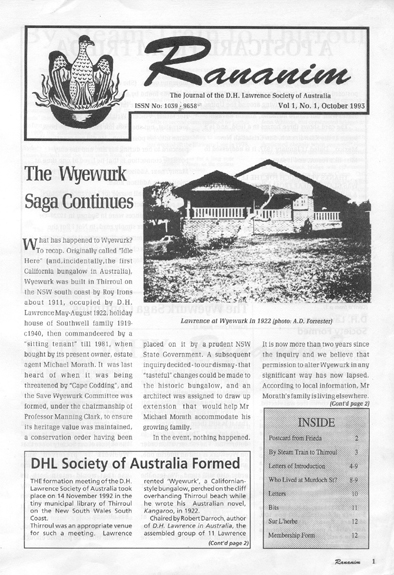
The
first issue of Rananim,
vol 1, no 1, October 1993
IN LATE 1993
we began publishing a journal, Rananim, to promote
the interests of our DH Lawrence Society, and to provide
a forum for articles on Lawrence's time in Australia,
his "Australian works", and local Lawrence studies
generally.
As well as becoming the main vehicle for disseminating
the results of my ongoing research, Rananim also
published the fruits of other people's research and contributions,
notably that of my loyal collaborators John Ruffels and
Andrew Moore (and, latterly, Robert Whitelaw), and my
chief fellow-heretic, my wife Sandra.
In 2008, Rananim, after 21 issues spread over a
period of 15 years, converted from "hard-copy"
format to an online journal. It is still "published"
at irregular intervals on our DHLA website - www.dhlawrencesocietyaustralia.com.au
.
One
of my early Rananim articles was headed "The
Barber of Thirroul" [Rananim, vol 2, no 1,
1994] and it picked up the point to which several others
had drawn attention (including Drs Steele, Ellis and Davis),
which was the possibility that Lawrence could have learned
about local political matters from "casual conversations"
with people he had encountered in Sydney and Thirroul.
Of course, identifying people whom Lawrence might have
talked to, casually or otherwise, in Sydney and Thirroul
was at the very heart of my research.
Some of the "factual" local material in the
novel - in particular its political content - had to have
come from somewhere or someone other than from Lawrence,
as he himself knew almost nothing about the place that
was to be, not only the setting to his novel, but which
was to provide its (highly unusual and unexpected) secret-army
plot.
One source for such information could have been printed,
as Dr Davis (and others) had pointed out. Lawrence might
have read about the local scene in Sydney newspapers,
or The Bulletin, or in books he might have read
during his stay.
And, indeed,
Lawrence mentions a number of such "sources"
in the text.
We
already know that he read The Bulletin, which,
as well as being a literary publication, also had a good
deal of political content.
